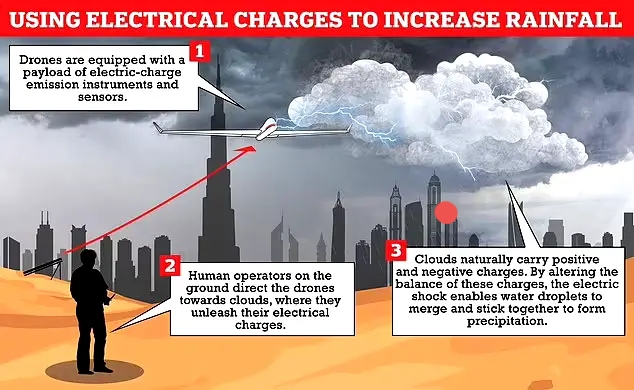In the blazing sunshine at Al-Ain airport, a twin-propeller Beechcraft stands ready to fly into action at a moment’s notice on a cloud-seeding mission (pictured above). The plane is armed with an array of salt flares which are fired into promising clouds to increase condensation and hopefully trigger a downpour. Source: MailOnline.
*Drone technology used to give clouds an electric shock
*This coaxes the clouds into clumping together, resulting in rains
*Plans underway to direct water from the skies to aquifer
With temperatures at 50 degrees Celsius, Dubai in the United Arab Emirates is creating its own rain using drones that fly into clouds and unleash electrical charges.
The charges give clouds electrics to ‘cajole them’ into clumping together and producing rain.
The UAE, one of the most arid countries on Earth, hopes the technique could help to increase its meagre annual rainfall. And it is working.
The Centre said the precipitation has been enhanced by a technique known as cloud seeding, and its purpose is to increase condensation in the hope that it might trigger a downpour.
The UAE’s cloud seeding operations are part of an ongoing $15 million (£10.8m) mission to generate rain in the country.
The country ranks among the world’s top 10 driest with an average rainfall of just three inches. This is six times less than what is obtainable in northern Nigeria.
The technology is led by experts at the University of Reading in the UK.
Professor Maarten Ambaum, who worked on the special project, had said the UAE had enough clouds to create conditions which allow for rainfall.
“When the drops merge and are big enough, they will fall as rain,” Professor Ambaum told BBC.
In 2017, the UAE government provided $15m for nine different rain-enhancement projects.
Among them is another cloud-seeding technology that launches salt missiles into clouds from planes.
The country’s Abu Dhabi-based forecasters monitor weather radars to tell pilots flying official government aircraft when to take off on rain-inducing missions.
“As soon as they see some convective cloud formations, they launch us on a flight to investigate,” said Mark Newman, deputy chief pilot at NCMS.
Other instances where the technology was applied were ski resorts in Colorado, USA, where it was use to induce heavier snowfall.
The former USSR also apparently used cloud seeding to prevent radioactive fallout from Chernobyl nuclear disaster in 1986 from reaching Moscow.
Also, ahead of the 2008 Beijing Olympics opening ceremony, it was used to create a downpour elsewhere and keep the stadium dry.
This involved firing rockets packed with silver iodide crystals into rain clouds over the suburbs of Beijing.
The UAE is also looking into methods to preserve the rain that does hit the ground, instead of allowing it to quickly evaporate or flow off into the sea.
It has built dams and reservoirs to gather water that flood desert valleys.
The country has around 130 dams and levees with a storage capacity of about 120 million cubic metre, according to the ministry report.
NCMS executive director Abdulla al-Mandoos said studies were being prepared to plan more dams and to protect water, aimed at directing rain ‘from the cloud right into the aquifer’.
“We do not want to waste a drop of water,” he said.
Source: MailOnline
